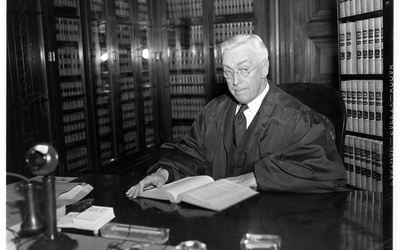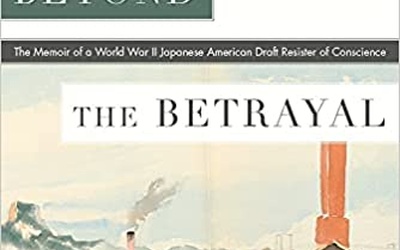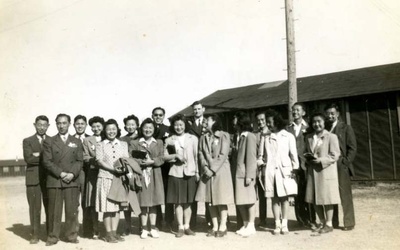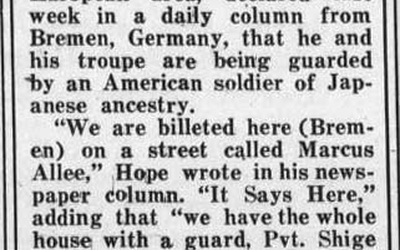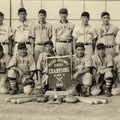
Jonathan van Harmelen
@jonathanJonathan van Harmelen is currently a Ph.D student in history at UC Santa Cruz specializing in the history of Japanese-American incarceration. He holds a BA in history and French from Pomona College and an MA from Georgetown University. He can be reached at jvanharm@ucsc.edu.
Updated February 2020
Stories from This Author
William Denman: A Voice of Dissent on the Courts - Part 1
June 8, 2022 • Jonathan van Harmelen
The U.S. judicial system, by and large, failed to protect the rights of the Japanese American community during World War II. Although the Justice Department, led by Attorney General Francis Biddle, opposed the forced removal of U.S. citizens of Japanese ancestry, in the end President Roosevelt approved mass removal, leading to mass incarceration. As Peter Irons noted in his landmark study Justice At War, the Supreme Court’s subsequent rulings in the cases of Gordon Hirabayashi, Minoru Yasui, and Fred Korematsu, …
Saving the Voices of the Past: An Interview with Arthur Hansen
May 20, 2022 • Jonathan van Harmelen
On June 4, 2022, the Japanese American National Museum will host an event in celebration of the publication of Yoshito Kuromiya’s edited memoir, Beyond the Betrayal: The Memoir of a World War II Japanese American Draft Resister of Conscience. As one of the few firsthand accounts of the Heart Mountain Draft Resisters, Kuromiya’s memoir is an important text that documents the personal views of one of the famed resisters. Beyond the Betrayal’s editor and distinguished historian Art Hansen, along with …
Daisuke Kitagawa: Civil Rights and Anti-Racism Activist — Part 2
May 9, 2022 • Jonathan van Harmelen
Read Part 1 >> Throughout the postwar years, Reverend Kitagawa remained in Minneapolis, where he maintained an active voice in local affairs as an expert on race relations while working for the Federal Council of Churches. In February 1946, Professor Frank Rarig of the University of Minnesota interviewed Reverend Kitagawa for a local Minneapolis radio station. During the interview, Kitagawa referenced forced removal of Japanese Americans, stating that the community had faced wrongful persecution, but he praised the members’ successful …
Daisuke Kitagawa: Civil Rights and Anti-Racism Activist — Part 1
May 8, 2022 • Jonathan van Harmelen
Throughout Japanese American history, a number of individuals have mobilized in response to incidents of racism facing their community. Along with calling for the end of anti-Japanese discrimination, a smaller number of Japanese American activists, of whom Yuri Kochiyama is perhaps the most prominent, have willingly connected their own experiences to broader issues of civil rights, by joining forces with African Americans. Several of these individuals have found their advocacy inspired by their spiritual duty to advocate for equal treatment …
Renaissance Artist and “Mad Man” – The Life of Shugo Seno
April 12, 2022 • Jonathan van Harmelen
The world of Japanese American visual artists is diverse. Most art historians focus on the notable individuals, such as Chiura Obata and Isamu Noguchi (among others), who produced paintings and sculpture. However, absent from this narrative is the work of various Japanese American commercial artists who influenced American popular art. Chris Ishii and Robert Kuwahara, who worked on various camp newspaper comics, were only two of a group of Japanese American animators who worked for Walt Disney and helped shape …
Reverend Aaron Allen Heist – A Profile in Courage
March 28, 2022 • Jonathan van Harmelen
On November 6, 1943, the California State Assembly’s Committee on the Japanese Problem convened in the small town of Santa Maria, California. Known throughout the state as an agricultural hub, Santa Maria and its twin town of Guadalupe had shared one of the state’s largest Japanese American agricultural communities until April 1942, when the government forced its members into camps under Executive Order 9066. At the November 1943 meeting, the committee, led by Assemblyman Chester Gannon, met with a group …
Bishop James Walsh – Priest and Prisoner
March 14, 2022 • Jonathan van Harmelen
This article forms a part of my continuing series on the presence of the Catholic Church in the Japanese American community. Although a number of clerics—Nikkei and non-Nikkei alike—worked with members of the ethnic Japanese communities of the West Coast, it would be difficult to tell the story of the Maryknolls without mentioning the contributions of Bishop James Edward Walsh, one of the founders of the order. Studying the career of Bishop Walsh helps us to understand the relationship of …
Looking South: Anglophone Canadian Reactions to Japanese American Incarceration - Part 2
March 1, 2022 • Jonathan van Harmelen
Read Part 1 >> In the eastern province of Quebec, a number of English-language newspapers tracked the wartime incarceration of Japanese Americans. It should be noted that, although French remained the majority language used in Quebec, several English-language newspapers existed and were patronized by the English-speaking elites of Quebec. The principle English papers in Quebec during the war years were The Montreal Gazette and The Montreal Star. The Gazette reported on the news of the incarceration regularly, often reprinting sensationalized …
Looking South: Anglophone Canadian Reactions to Japanese American Incarceration - Part 1
Feb. 28, 2022 • Jonathan van Harmelen
As I have discussed in previous articles in Discover Nikkei, the news of the mass incarceration of Japanese Americans during World War II seeped beyond the borders of the U.S. and traveled around the world. In Japan and Axis-dominated Europe, news outlets picked up the story as proof of the hypocrisy of Americans in proclaiming democratic ideals but persecuting their own citizens on racial grounds. Likely the most intensive foreign coverage of the incarceration took place to the north. In …
An Active Voice: The New Republic’s Reportage on the Incarceration - Part 2
Jan. 26, 2022 • Jonathan van Harmelen
Read part 1 >> Along with publishing the opinions of intellectuals and government officials, The New Republic remained one of the few mainstream periodicals to offer a forum for the views of Japanese Americans themselves. In prewar years, Nisei activists Franklin and Robert Asahi Chino wrote letters to the New Republic in response to their articles. The first publication from a Japanese American was architect Ted Nakashima’s provocatively-titled article, “Concentration Camps: U.S. Style,” which appeared in the June 15, 1942 …

